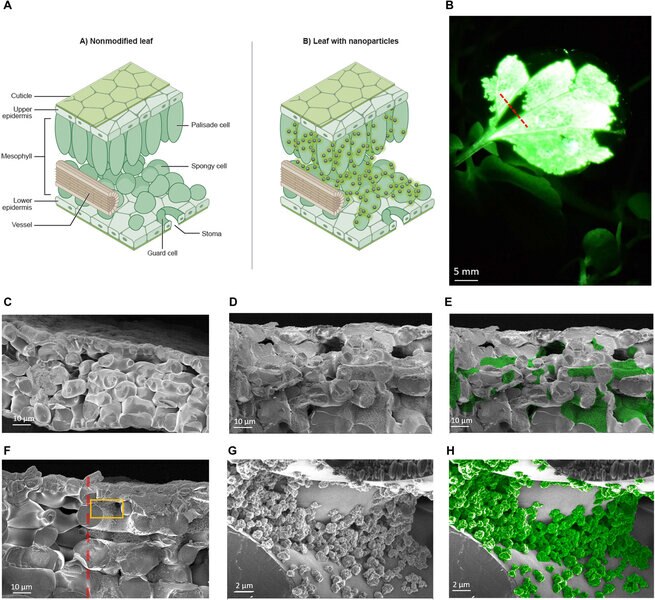Create a free profile to get unlimited access to exclusive videos, sweepstakes, and more!
Real-life chargeable nanoparticles light the way toward Avatar's alien future of luminescent plants

James Cameron’s Avatar presented a world so beautiful moviegoers flocked to theaters to the tune of more than $2.7 billion, making it the highest grossing film for almost a decade, spawning a theme park, and a slate of looming sequels. Pandora’s many varied fauna and flora captured audience imaginations — and now scientists are working on bringing the luminescent tree of souls to life, here on Earth.
Interest in modifying living plants to emit light isn’t precisely new. Previous research has involved the genetic modification of plants with genes from autoluminescent mushrooms. New research by Michael S. Strano, the Carbon P. Dubbs Professor at MIT’s Chemical Engineering department, and colleagues, builds on the previous work by incorporating nanoparticles which act as a capacitor. The results were published in the journal Science.
In previous studies, modified plants used their own ATP to power light creation. This process works pretty well but has a moderately short active period of approximately four hours. In order to design lit plants capable of lasting the night, scientists need to extend the period of luminosity. “They’re very bright at first, sort of a surge,” Strano told SYFY WIRE. “One reason is the plant has a lot of stored ATP, but the light decays over time. These new nanoparticles can take that spike in light, absorb it, and re-emit it over a longer time period.”
The particles Strano used had to be made very small, roughly 50,000 times smaller than the thickness of a human hair, in order to make it through the stomata pores in the leaves. Creating the nanoparticles involved a modified wet-milling process wherein strontium aluminate powder was added to ethyl acetate in a jar. Zirconia cylinders rotated to grind the powder down before the powder was removed and dried. Later, the particles were placed in a centrifuge in order to sort them by size and identify those small enough for use.
In order to be used inside plants, Strano and team had to ensure they were biocompatible, able to be implanted without otherwise compromising the plant’s health. Particles at this stage, showed a significant impact on pH levels, raising the pH in solution from 7 to as high as 14. To prevent this reaction in plants, the particles were treated with a silica coating.
Once treated, nanoparticles were introduced to the mesophyll—a spongy layer of tissue between the upper and lower epidermis—where they spread. The mesophyll is where the plant stores water waiting to evaporate. Introducing nanoparticles to this part of the plant exhibited sufficient distribution across the leaf without significantly inhibiting chlorophyll production or photosynthesis. By all accounts, the plants had little or no negative reaction.
Five different plant species were used, tobacco, basil, daisy, watercress, and elephant ear. Light emission occurred in all five species, but with variable results, which is believed to relate to mesophyll surface area across different species.
The long-term aim is to replace existing synthetic lights with modified plants for more sustainable in-home and community lighting options. Today, lamps and lightbulbs are constructed with materials which ultimately end up in landfills and are often toxic. “The types of materials you can use to create products are restricted,” Strano said. “But there is an exception for lighting because there’s no other way to make a light. The question is, can we take that lightbulb and replace it with a living plant?”
Elephant ears may be a model plant for this sort of application. They grow large leaves, up to eight feet depending on location, and they demonstrate significant distribution of nanoparticles across their mesophyll layer. According to Strano, the vasculature of an elephant ear is such that you can coat the entire leaf with only a few injections.
Should the project reach a stage where nanoparticle-modified plants are introduced to the outside world, there is a question of maintenance. As the leaf grows, previously infused tissue regions would maintain their particles, but new tissues would not, necessitating additional injections. Furthermore, there’s a question of particle retrieval in the event the plant dies.
It’s worth noting that even without retrieval, the amount of waste introduced to the environment would be minimal when compared with fully manufactured lights. Still, because the aim is sustainability, the team asked themselves if they could create circular economy of nanoparticles. They found approximately 60 percent could be retrieved from inside an infused plant, and those nanoparticles could be re-used.
Strano envisions a future where synthetic lights are replaced with living plants capable of creating their own light, absorbing and re-emitting light, or some combination of the two. “The aim,” Strano said, “is combining techniques, working on how to get them to synergize.”
More plants, less trash. That’s a vision worth shining a light on.















